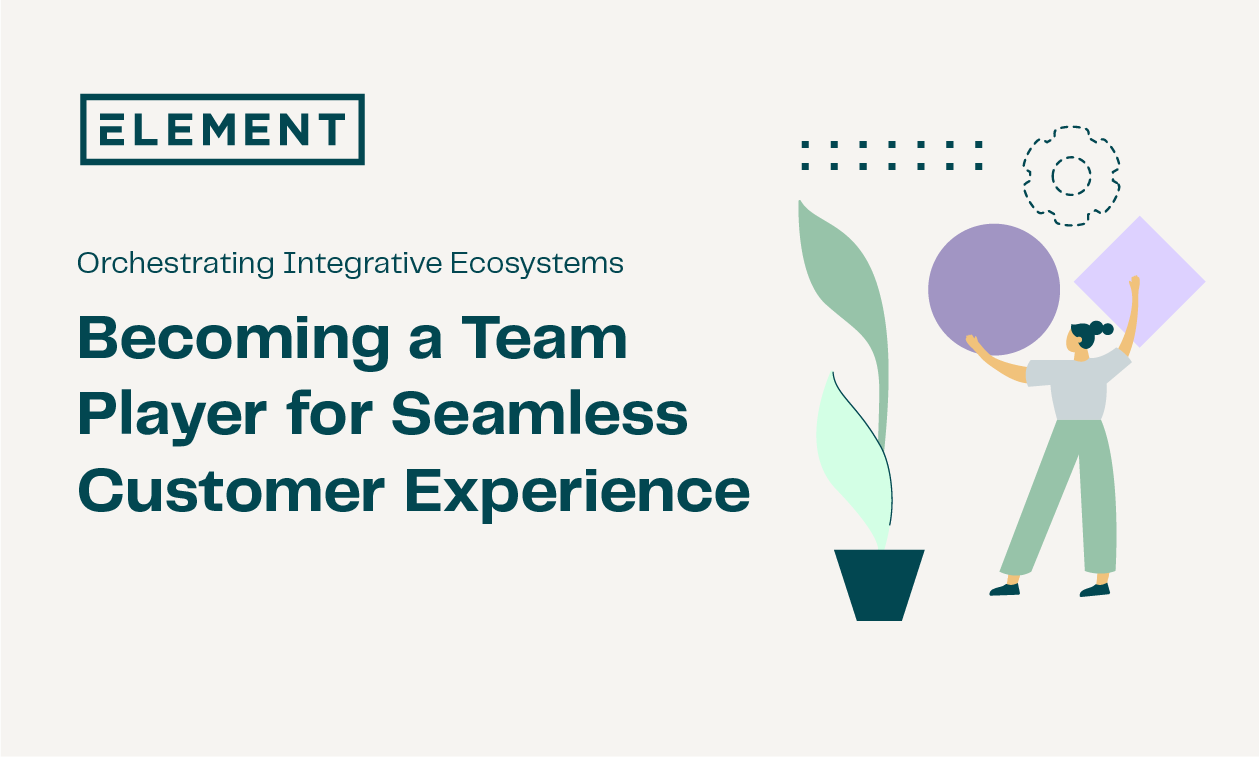
Orchestrating Integrative Ecosystems: Becoming a Team Player for Seamless Customer Experience
Key Question: As an insurer, do you want to, and are able to play in a team?
Integrative ecosystems strive to offer a seamless customer experience to the end-users. How do they achieve that? Each individual team player concentrates on their core competence. Different team players connect seamlessly and are not necessarily previously linked through a holding company, but through certain values, rules and shared technologies. Picture an orchestra, where various musical instruments possess distinct sound qualities, volumes, and tones. Each instrument has a unique and irreplaceable role. However, when played simultaneously without harmony, it can be an unpleasant experience. The true beauty for the listener lies in the harmonious combination of these instruments to create a symphony for the ears.
In this blog article, we aim to delve into the orchestration occurring both on stage and behind the scenes, discussing the playbook on "how to successfully be a team player" in this ballet.
The ecosystem of experience
Similarly, in our vision of the future, we envision the customer experience in a similar way to a symphony in an opera house. The orchestration of all different touchpoints is key in examples, such as the purchase of all-inclusive flight packages with various offerings, or even complete bicycle tour packages that include full service.
The aim is for the customer not to be burdened with worrying about potential life situations, such as an accident during the bike tour – if this happens, accommodation will be reserved directly, and a spare bicycle provided while your own is being repaired. The service is provided proactively, and the customer needs not concern themselves with the intricacies of behind-the-scenes operations. What truly matters is the absence of any "gaps" in the experience, ensuring it feels seamless, meticulously designed, and dependable.
Only those who know their team and coordinate their strengths with those of the rest of the players will be successful. The customer experience should be constantly analyzed from start to finish, with improvements identified and adjustments promptly implemented. The lasting success of the service experience can only be achieved through continuous optimization. As an insurer, it's essential to prioritize your core competencies while actively engaging with all relevant interfaces.
The role of an insurer
Now, let's define the insurer's role within the "bike tour" experience. Fundamentally, the insurer's primary responsibility is to safeguard the bike owner against potential future losses – that can occur during this time. This proactive involvement extends to evaluating risks associated not only with the bike service - which can range from damage to breakdowns and necessary part replacements - but also to accommodation and the rental itself. Leveraging their expertise, insurers excel in providing competitive pricing and effective underwriting tailored to the unique needs of the bike rider experience .
Following this initial phase of evaluating the risks, collaboration becomes crucial. Insurers must align with various key stakeholders in the ecosystem, including emergency assistance providers during bike trips, travel agencies, accommodation, repair shops and other companies supporting in the claims process, and even other intermediaries in the insurance value chain. This collaborative effort ensures swift and efficient experience and solution of an unexpected event for the bike rider. Ultimately, the insurer's role serves as the foundation, instilling a profound sense of assurance and confidence throughout the journey.
Key factors for effective teamwork
Effective teamwork is the cornerstone of success in any ecosystem, and the world of insurance is no exception. In order to achieve a seamless experience for our end customers, but also for our partners while engaging with relevant parties, insurers must prioritize effective teamwork.
Successful collaboration requires a deep understanding of each stakeholder's requirements, align the business objectives, and appoint relationship managers or teams to maintain and manage relationships with each stakeholder. Next to these elements, the key factors for effective team management are:
1. Collaboration on eye level
It goes beyond mere cooperation; it involves a deep sense of trust, respect, and mutual support among team members. The emphasis is on valuing each partner's contributions and understanding the unique strengths they bring to the team, supporting each other to improve the end-to-end value chain. It is not about mistrust, extreme controlling or finger pointing. Instead, collaboration on eye level fosters an environment where team members genuinely understand each other's perspectives and what they bring to the table. It's a commitment to shared success, emphasising unity over division.
2. Same understanding of the customer experience and the requirement to fulfil it
As previously emphasised, the ultimate beneficiary of this orchestrated effort is the end customer who gets to enjoy the symphony of a flawless customer experience. In a perfect integrated team, every team member knows the customer needs and have the same understanding and commitment to fulfil it. This shared understanding forms the basis for a collective commitment to delivering the best possible outcome. By having a clear vision of the customer experience requirements, individual contribution can be aligned towards a common goal for all team members. This alignment not only streamlines the workflow but also ensures a consistent and fitting experience for the end customer.
3. Same understanding of endless optimization
Achieving and maintaining the perfect customer experience requires a mindset that values continuous learning, adaptability, and a proactive approach to improvement. Every team player should be committed to optimizing end-to-end processes, always seeking ways to enhance efficiency and effectiveness. The success or failure of the team hinges on this collective mindset — if you stop improving after the first go live failure is very close. Therefore, a culture of perpetual optimization is indispensable for sustained success in delivering an unparalleled customer experience.
For continuous optimization, data sharing and analysis is essential. Stakeholders should work together to collect and analyze data to gain insights into consumer behavior, market trends and performance metrics. Using this data enables informed decision making and strategy development. With the help of technology - digital platforms and tools – it's possible enable the efficient sharing of data, making information accessible to all relevant parties. We will explore the role of technology in more detail in our third blog article of these series.
Conclusion
As we reflect on the symphony of integrative ecosystems, the key crescendo lies in continuous optimization. Much like a skilled conductor refining their performance, insurers must constantly analyze the customer experience. Identifying areas for improvement and promptly implementing adjustments, the ecosystem evolves, ensuring its resonance with the ever-changing needs of the market.
In essence, being a team player in integrative ecosystems transcends mere collaboration; it embodies a commitment to co-create, adapt, and harmonize. Insurers, as integral components of this symphony, hold the responsibility not only to carry the risk but also to enhance, enriching the customer experience and ensuring that the melody of flawless collaboration continues to echo, creating a harmonious work with the rest of the players and an experience for the end customer.

